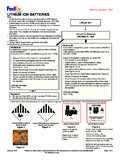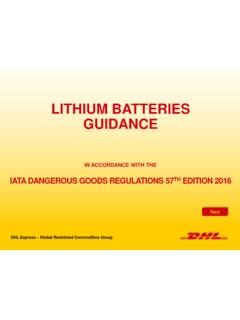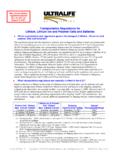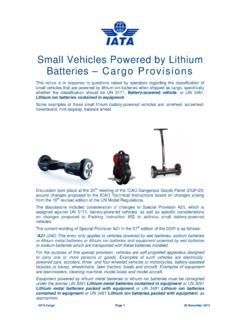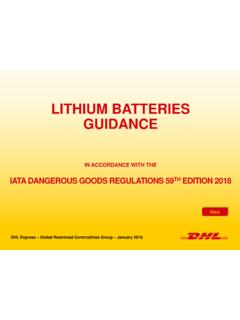Transcription of Power Management in Portable Applications: Charging ...
1 AN947. Power Management in Portable Applications: Charging lithium -Ion/ lithium -Polymer batteries Author: Scott Dearborn and cathode, respectively. By definition, the cathode Microchip Technology Inc. (oxidizing electrode) is the electrode that accepts electrons from the external circuit and is reduced dur- ing the electrochemical reaction. The anode (reducing INTRODUCTION electrode) is the electrode which gives up electrons to the external circuit and is oxidized during the electro- Powering today's Portable world poses many chal- chemical reaction. The electrolyte (ionic conductor). lenges for system designers. The use of batteries as a provides the medium for transfer of charge, as ions, prime Power source is on the rise.
2 As a result, a burden inside the battery between the anode and cathode. has been placed on the system designer to create sophisticated systems utilizing the battery's full Electron Flow potential. Each application is unique, but one common theme Load rings true: maximize battery capacity usage. This +. theme directly relates to how energy is properly restored to rechargeable batteries . While no single Cathode Anode method is ideal for all battery chemistries, an under- Flow of Anions standing of the Charging characteristics of the battery, along with the application's requirements, is essential Flow of Cations when designing an appropriate and reliable battery- Charging system.
3 Each method has its associated advantages and disadvantages, with the particular Electrolyte application (and its individual requirements). determining the best method to use. FIGURE 1: Discharge of a Battery. This application note focuses on the fundamentals of When recharging a battery, the current flow is reversed, Charging lithium -Ion/ lithium -Polymer batteries . In with oxidation occurring at the positive electrode and particular, a linear, stand-alone solution utilizing reduction at the negative electrode. As the anode is, by Microchip's MCP73841 will be explored. definition, the electrode at which oxidation occurs and the cathode where reduction occurs, the positive elec- BATTERY OVERVIEW trode is now the anode and the negative electrode is the cathode.
4 Refer to Figure 2. A battery is a device that converts the chemical energy contained in its active materials directly into electric Electron Flow energy by means of an electrochemical oxidation- reduction (redox) reaction. This type of reaction involves the transfer of electrons from one material to DC. another through an electric circuit. In a non-electro- Supply + +. chemical redox reaction, such as rusting or burning, the Cathode transfer of electrons occurs directly and only heat is Anode Flow of Anions involved. The operation of a battery during discharge is depicted Flow of Cations schematically in Figure 1. When the electrodes (posi- tive and negative terminals of the battery) are con- nected to an external load, electrons flow from the Electrolyte anode, which is oxidized, through the external load to the cathode.
5 The cathode accepts the electrons and FIGURE 2: Charge of a Battery. the cathode material is reduced. The electric circuit is completed in the electrolyte by the flow of anions (negative ions) and cations (positive ions) to the anode 2004 Microchip Technology Inc. DS00947A-page 1. AN947. The standard potential of a battery is determined by the type of active materials contained in the battery. It can CONTAINER, be calculated from free-energy data or obtained exper- TERMINALS, imentally. The standard potential of a battery can be SEALS, calculated from the standard electrode potentials as CATHODE. ETC. ANODE. follows (the oxidation potential is the negative value of CURRENT CURRENT.)
6 The reduction potential): COLLECTOR COLLECTOR. ELECTRO. Anode (oxidation potential) LYTE. + Cathode (reduction potential). CATHODE ANODE. Standard Potential MATERIAL MATERIAL. For example, in a NiCd battery: Cathode: SEPARATOR. 2 NiOOH + 2H2O + 2e ---- 2Ni(OH)2 + 2OH- = Anode: FIGURE 3: Components of a Battery. Cd + 2OH- ---- Cd(OH)2 + 2e = The weight of the materials of construction reduces the Standard Potential: theoretical energy density of the battery by almost ( ) = 50%, with the actual energy delivered by a practical battery (even when discharged under conditions close The theoretical capacity of a battery is determined by to optimum) possibly being 50% to 75% of that lowered the amount of active materials in the battery.
7 It is , the actual energy available from a battery expressed as the total quantity of electricity involved in under practical discharge conditions is only about 25%. the electrochemical reaction and is defined in terms of to 35% of the theoretical energy of the active materials. coulombs (C) or ampere-hours (Ah). The ampere-hour Referring to Figure 4, the theoretical voltage of a capacity of a battery is directly associated with the battery, as defined previously, is equivalent to the open- quantity of electricity obtained from the active circuit voltage of a fully charged battery. When an materials. Theoretically, 1 gram equivalent weight of electrical circuit is connected around the battery, with material will deliver 96,487C or Ah.
8 (A gram current being drawn from the battery, the closed-circuit equivalent weight is the atomic or molecular weight of voltage potential will be lower than the open-circuit the active material in grams divided by the number of voltage. This is due to two factors: electrons involved in the reaction.) The capacity of a battery can also be considered on an energy (watthour) 1. The electrodes have real impedance. basis by taking both the voltage and the quantity of 2. The rate at which current can be drawn from the electricity into consideration. This theoretical energy battery is restricted by the rate at which the value is the maximum value that can be delivered by a chemical reaction occurs.
9 This looks like resis- specific electrochemical system. tance to the electrical circuit and can be The maximum energy that can be delivered by an modeled as resistance in series with the electrochemical system is based on the types of active cathode. materials that are used (this determines the voltage) The nominal voltage is the voltage at the plateau of and the amount of active materials that are used (this the discharge curve. For NiCd and NiMH batteries , the determines the ampere-hour capacity). In practice, nominal voltage is For a lithium -Ion battery, the only a fraction of the theoretical energy of the battery is nominal voltage is The end voltage is defined by realized.
10 This is due to the need for the electrolyte and the system and is the potential at which the system no non-reactive components (containers, separators, longer draws current from the battery. The discharge seals, etc.) that add to the weight and volume of the cut-off voltage is a secondary safety potential, below battery. which the battery can experience irrepairable damage. DS00947A-page 2 2004 Microchip Technology Inc. AN947. Primary cells produce an irreversible chemical Open-Circuit Voltage reaction. Zinc Carbon batteries were the first intro- duced. The carbon was later purified to increase the Closed-Circuit Voltage energy capacity. These cells are more readily known as Zinc Chloride.










